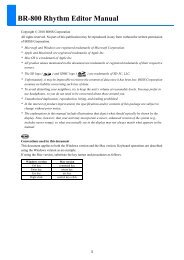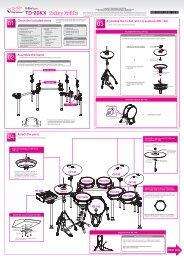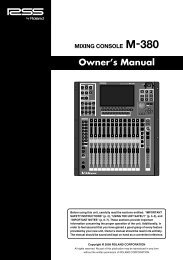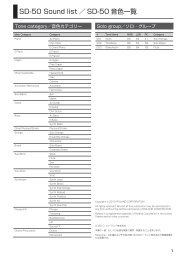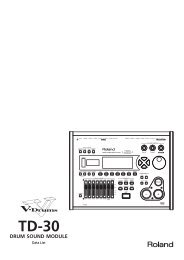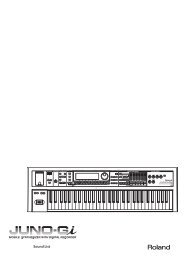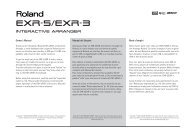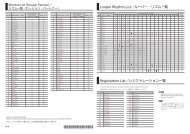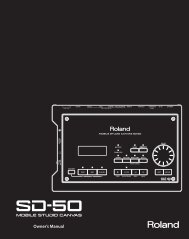GAIA Exploring Sound (PDF) - Roland Corporation Australia
GAIA Exploring Sound (PDF) - Roland Corporation Australia
GAIA Exploring Sound (PDF) - Roland Corporation Australia
Create successful ePaper yourself
Turn your PDF publications into a flip-book with our unique Google optimized e-Paper software.
Section 7<br />
TONES 2 and 3<br />
In reality, we’d prefer you to go back and ask all those questions<br />
again about TONES 2 & 3. However, by starting with the Global<br />
Questions on pages 160 and 161 we can already rule out many<br />
of those questions.<br />
This is because we already established that TONES 2 and 3<br />
appear to have started as copies of TONE 1. Indeed, the only<br />
real differences appear to be in the Oscillators and LFOs.<br />
So we’ll select just a few questions for now:<br />
What Oscillator wave shape has been used?<br />
Both TONES have used a variation of the Sawtooth waveform.<br />
The programmer could have added more SuperSaw, but has<br />
instead taken the more subtle approach. Since TONES 2 and 3<br />
are panned left and right perhaps they are there just to add<br />
“width” to the sound.<br />
What can be learnt from the Pitch and<br />
Detune settings?<br />
Even though these two TONES are a subtle addition to the<br />
overall Patch, they feature some unique decisions. Clearly the<br />
programmer wanted to add more modulation, and this has been<br />
enhanced by detuning these two TONES.<br />
What LFO Shape has been used?<br />
Both TONES 2 and 3 use the Random LFO waveform. As we<br />
mentioned, this has added a “mosquito-like” quality to their<br />
sound. Actually, it is almost as if these sounds come from very<br />
badly made, or unstable, oscillators.<br />
Traditional analog synthesizers had problems with stability, so by<br />
adding some random LFO the programmer has successfully<br />
recreated that type of sound.<br />
This is a very interesting point; sometimes a sound can be<br />
improved by recreating all that was unacceptable in the original.<br />
You have already used this idea when creating the noisy release<br />
of an electric piano back in Lesson 11.<br />
166




